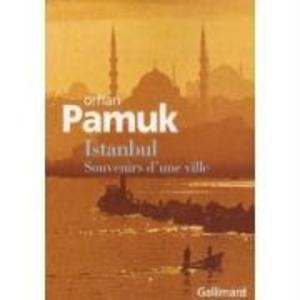
Zustellung: Sa, 21.12. - Mo, 30.12.
Versand in 3-4 Wochen
VersandkostenfreiBestellen & in Filiale abholen:
Für das tagträumende Kind, den jungen Orhan Pamuk war das Herz der großen Stadt Istanbul das Gebäude, das unter dem Namen Pamuk Apartmani"bekannt war. Hier lebte die Großfamilie, hier lebten Onkel, Tanten, Großmütter, jeder Zweig der Familie auf einem eigenen Stock. Nun schildert der Schriftsteller Orhan Pamuk mit seinem einzigartigen Gespür für Geschichte und seiner außergewöhnlichen erzählerischen Begabung die Geheimnisse seiner eigenen Familie und entdeckt, inwiefern sie typisch für ihre Zeit und diesen bestimmten Ort waren. Er führt uns an die berühmten Monumente und verlorenen Paradiese der sagenhaften Stadt, zeigt uns die verfallenden osmanischen Villen, die Wasserstraßen des Bosporus und des Goldenen Horns, die dunklen Gassen der Altstadt und berichtet von Malern, Dichtern und Mördern. Unter Pamuks Händen verwandelt sich die Autobiographie, und was als Porträt des Schriftstellers als junger Mann beginnt, wird das Porträt einer außerordentlichen Stadt.
A portrait, by turns intimate and panoramic, of one of the world's great cities, by its foremost man of letters, author of the acclaimed novels "Snow and "My Name Is Red.
Blending reminiscence with history; family photographs with portraits of poets and pashas; art criticism, metaphysical musing, and, now and again, a fanciful tale, Orhan Pamuk invents an ingenious form to evoke his lifelong home, the city that forged his imagination. He begins with his childhood among the eccentric extended Pamuk family in the dusty, carpeted, and hermetically sealed apartment building they shared. In this place came his first intimations of the melancholy awareness that binds all residents of his city together: that of living in the seat of ruined imperial glories, in a country trying to become "modern" at the dizzying crossroads of East and West. This elegiac communal spirit overhangs Pamuk's reflections as he introduces the writers and painters (among the latter, most particularly the German Antoine-Ignace Melling) through whose eyes he came to see Istanbul. Against a background of shattered monuments, neglected villas, ghostly backstreets, and, above all, the fabled waters of the Bosphorus, he presents the interplay of his budding sense of place with that of his predecessors. And he charts the evolution of a rich, sometimes macabre, imaginative life, which furnished a daydreaming boy refuge from family discord and inner turmoil, and which would continue to serve the famous writer he was to become. It was, and remains, a life fed by the changing microcosm of the apartment building and, even more, the beckoning kaleidoscope beyond its walls.
As much a portrait of the artist as a young manas it is an oneiric Joycean map of the city, "Istanbul is a masterful evocation of its subject through the idiosyncrasies of direct experience as much as the power of myth--the dazzling book Pamuk was born to write.
Blending reminiscence with history; family photographs with portraits of poets and pashas; art criticism, metaphysical musing, and, now and again, a fanciful tale, Orhan Pamuk invents an ingenious form to evoke his lifelong home, the city that forged his imagination. He begins with his childhood among the eccentric extended Pamuk family in the dusty, carpeted, and hermetically sealed apartment building they shared. In this place came his first intimations of the melancholy awareness that binds all residents of his city together: that of living in the seat of ruined imperial glories, in a country trying to become "modern" at the dizzying crossroads of East and West. This elegiac communal spirit overhangs Pamuk's reflections as he introduces the writers and painters (among the latter, most particularly the German Antoine-Ignace Melling) through whose eyes he came to see Istanbul. Against a background of shattered monuments, neglected villas, ghostly backstreets, and, above all, the fabled waters of the Bosphorus, he presents the interplay of his budding sense of place with that of his predecessors. And he charts the evolution of a rich, sometimes macabre, imaginative life, which furnished a daydreaming boy refuge from family discord and inner turmoil, and which would continue to serve the famous writer he was to become. It was, and remains, a life fed by the changing microcosm of the apartment building and, even more, the beckoning kaleidoscope beyond its walls.
As much a portrait of the artist as a young manas it is an oneiric Joycean map of the city, "Istanbul is a masterful evocation of its subject through the idiosyncrasies of direct experience as much as the power of myth--the dazzling book Pamuk was born to write.
Produktdetails
Erscheinungsdatum
15. Oktober 2008
Sprache
französisch
Seitenanzahl
547
Reihe
Folio
Autor/Autorin
Orhan Pamuk
Übersetzung
Savas Demirel, Valerie Gay-Aksoy
Verlag/Hersteller
Produktart
kartoniert
Gewicht
282 g
Größe (L/B/H)
180/108/43 mm
ISBN
9782070358601
Bewertungen
0 Bewertungen
Es wurden noch keine Bewertungen abgegeben. Schreiben Sie die erste Bewertung zu "Istanbul" und helfen Sie damit anderen bei der Kaufentscheidung.










